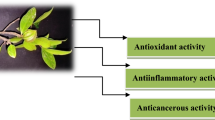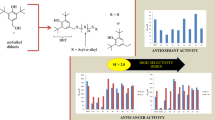Abstract
In the present study, we have experimentally and theoretically studied the free-radical quenching property of dihydrocanaric acid (DCA) isolated from seedpods of Holarrhena antidysenterica. A modified method was used to estimate the nitric oxide scavenging effect of the DCA (significant activity of 75.22%) along with methanolic extract of seed pods of Holarrhena antidysenterica (72.80%) compared to the ascorbic acid as standard (40.60%). Studies have also been conducted for superoxide scavenging activity of the DCA (78.82%) and methanolic extract of seed pods (84.28%) compared to quercetin as standard (82.08%). Theoretically, it has been determined by density-functional theory(DFT) calculations using M06-2X hybrid functional and the double-ζ- split-valence 6-31G (d, p) basis set that the nitric oxide scavenging activity of the compound is by the addition of NO radical at double bond position. Predicted biological activity profile of DCA suggests that it has less activity probability (Pa) for toxicity (Pa = 0.730), cytotoxicity (Pa = 0.208), compared to those chemical entities that are already known as anticancer agents indicating that DCA is less toxic and more tolerable for normal cells. Furthermore, molecular docking studies of the DCA with different studied cancer-related receptors [Estrogen receptor (− 60.12 kcal/mol), epidermal growth factor receptor (EGFR) (− 30.33 kcal/mol), estrogen receptor alpha (− 4.82 kcal/mol), uPAR (− 32.55 kcal/mol) and an enzyme having lipid kinase activity phosphoinositide 3-kinase (− 55.94 kcal/mol)] were found to have better binding affinities compared to betulinic acid and doxorubicin. Thus, our findings suggest that the DCA could be a safer and effective alternative in fighting cancer with minimal side effects.



Similar content being viewed by others
References
Agudelo D, Bourassa P, Bruneau J, Berube G, Asselin É, Tajmir-Riahi H-A (2012) Probing the binding sites of antibiotic drugs doxorubicin and N-(trifluoroacetyl) doxorubicin with human and bovine serum albumins. PLoS ONE 7(8):e43814
Berman HM, Westbrook J, Feng Z, Gilliland G, Bhat TN, Weissig H, Shindyalov IN, Bourne PE (2000) The protein data bank. Nucleic Acids Res 28(1)
Boonstra MC, Van Driel PBAA, Keereweer S, Prevoo HAJM, Stammes MA, Baart VM, Sier FM (2017) Preclinical uPAR-targeted multimodal imaging of locoregional oral cancer. Oral Oncol 66:1–8
Brand MD (2016) Mitochondrial generation of superoxide and hydrogen peroxide as the source of mitochondrial redox signaling. Free Radic Biol Med 100:14–31
Cadenas E, Davies KJ (2000) Mitochondrial free radical generation, oxidative stress, and aging. Free Radic Biol Med 29(3–4):222–230
Cortiula F, De Maglio G, Cangi MG, Gerratana L, Lisanti C, Bonura S, Fasola G, Follador A (2019) Third-generation tyrosine kinase inhibitor in the treatment of epidermal growth factor receptor mutated squamous cell lung cancer: a tailored therapy approach. Ann Transl Med 7(1)
Das S, da Silva CJ, Silva MDM, Dantas MDDA, de Fátima Â, Ruiz ALTG, da Silva-Júnior EF (2018) Highly functionalized piperidines: Free radical scavenging, anticancer activity, DNA interaction and correlation with biological activity. Journal of advanced research, 9, 51–61
Dizdaroglu M, Jaruga P, Birincioglu M, Rodriguez H (2002) Free radical-induced damage to DNA: mechanisms and measurement. Free Radic Biol Med 32(11):1102–1115
Droge W (2002) Free radicals in the physiological control of cell function. Physiol Rev 82(1):47–95
Ertuğ PU, Aydinoglu F, Ozturk OG, Singirik E, Ögülener N (2013) Comparative study of the quercetin, ascorbic acid, glutathione and superoxide dismutase for nitric oxide protecting effects in mouse gastric fundus. Eur J Pharmacol 698(1–3):379–387
Eswaramoorthy S, Kumaran D, Swaminathan S (2001) Crystallographic evidence for doxorubicin binding to the receptor-binding site in Clostridium botulinum neurotoxin B. Acta Crystallogr D Biol Crystallogr 57(11):1743–1746
Filimonov D, Lagunin A, Gloriozova T, Rudik A, Druzhilovskii D, Pogodin P, Poroikov V (2014) Prediction of the biological activity spectra of organic compounds using the PASS online web resource. Chem Heterocycl Compd 50(3):444–457
Fujita K, Nonomura N (2019) Role of androgen receptor in prostate cancer: a review. World J Men's Health 37(3):288–295
Gangwar M, Gautam MK, Sharma AK, Tripathi YB, Goel RK, Nath G (2014) Antioxidant capacity and radical scavenging effect of polyphenol rich Mallotus philippenensis fruit extract on human erythrocytes: an in vitro study. Sci World J 2014:1–12
Genestra M (2007) Oxyl radicals, redox-sensitive signalling cascades and antioxidants. Cell Signal 19(9):1807–1819
Ghosh A, Banerji A, Mandal S, Banerji J (2009) A new sesquiterpenoid coumarin from Ferula assafoetida. Nat Product Commun 4(8):1934578X0900400801
Green LC, Wagner DA, Glogowski J, Skipper PL, Wishnok JS, Tannenbaum SR (1982) Analysis of nitrate, nitrite, and [15N] nitrate in biological fluids. Anal Biochem 126(1):131–138
Iqbal J, Abbasi BA, Mahmood T, Kanwal S, Ali B, Shah SA, Khalil AT (2017) Plant-derived anticancer agents: a green anticancer approach. Asian Pac J Tropical Biomed 7(12):1129–1150
Khan MA, Rahman MM, Sardar MN, Arman MSI, Islam MB, Khandakar MJA, Alam AK (2016) Comparative investigation of the free radical scavenging potential and anticancer property of Diospyros blancoi (Ebenaceae). Asian Pac J Tropical Biomed 6(5):410–417
Kim S, Thiessen PA, Bolton EE, Chen J, Fu G, Gindulyte A, Shoemaker BA (2015) PubChem substance and compound databases. Nucleic Acids Res 44(D1):D1202–D1213
López-Romero R, Rodríguez-Esquivel M, Romero-Morelos P, García-Avilés JE, Serafín-Castillo A, Huerta Padilla VM, Martínez-Castillo MA (2019) The expression of transcription factor BORIS and its association with the estrogen receptor beta (ER-β) in cervical carcinogenesis. Int J Clin Exp Pathol 12(9):3208
Mandal S, Hazra B, Sarkar R, Biswas S, Mandal N (2011) Assessment of the antioxidant and reactive oxygen species scavenging activity of methanolic extract of Caesalpinia crista leaf. Evid-Based Complement Alternat Med 2011:1–11
Marcocci L, Packer L, Droy-Lefaix M-T, Sekaki A, Gardès-Albert M (1994) [46] Antioxidant action of Ginkgo biloba extract EGb 761. Methods in enzymology, vol 234. Elsevier, Amsterdam, pp 462–475
Mitra S, Dash R (2018) Natural products for the management and prevention of breast cancer. Evid-Based Complement Alternat Med 2018:1–23
Newman DJ, Cragg GM (2016) Natural products as sources of new drugs from 1981 to 2014. J Nat Prod 79(3):629–661
Nimse SB, Pal D (2015) Free radicals, natural antioxidants, and their reaction mechanisms. Rsc Adv 5(35):27986–28006
Pacher P, Beckman JS, Liaudet L (2007) Nitric oxide and peroxynitrite in health and disease. Physiol Rev 87(1):315–424
Pham-Huy LA, He H, Pham-Huy C (2008) Free radicals, antioxidants in disease and health. Int J Biomed Sci 4(2):89
Pourahmad J, Salimi A, Seydi E (2016) Role of oxygen free radicals in cancer development and treatment. In Free radicals and diseases, vol 16. IntechOpen, pp 315–330
Raut PK, Kim SH, Choi DY, Jeong GS, Park PH (2019) Growth of breast cancer cells by leptin is mediated via activation of the inflammasome: critical roles of estrogen receptor signaling and reactive oxygen species production. Biochem Pharmacol 161:73–88
Rayan A, Raiyn J, Falah M (2017) Nature is the best source of anticancer drugs: Indexing natural products for their anticancer bioactivity. PLoS ONE 12(11):e0187925
Sharma V, Hussain S, Bakshi M, Bhat N, Saxena AK (2014) In vitro cytotoxic activity of leaves extracts of Holarrhena antidysenterica against some human cancer cell lines. Indian J Biochem Biophys 51:46–51
Srimathi PK, Vijayalakshmi K (2017) Investigation of antioxidant potential of quercetin and hesperidin: an in vitro approach. Asian J Pharma Clin Res. https://doi.org/10.22159/ajpcr.2017.v10i11.20260
Trinity JD, Broxterman RM, Richardson RS (2016) Regulation of exercise blood flow: role of free radicals. Free Radic Biol Med 98:90–102
Yueh AE, Payne SN, Leystra AA, Van De Hey DR, Foley TM, Pasch CA, Deming DA (2016) Colon cancer tumorigenesis initiated by the H1047R mutant PI3K. PloS one 11(2)
Zhao Y, Truhlar DG (2008a) Density functionals with broad applicability in chemistry. Acc Chem Res 41(2):157–167
Zhao Y, Truhlar DG (2008b) The M06 suite of density functionals for main group thermochemistry, thermochemical kinetics, noncovalent interactions, excited states, and transition elements: two new functionals and systematic testing of four M06-class functionals and 12 other functionals. Theoret Chem Acc 120(1–3):215–241
Zhao RZ, Jiang S, Zhang L, Yu ZB (2019) Mitochondrial electron transport chain, ROS generation and uncoupling. Int J Mol Med 44(1):3–15
Acknowledgements
Sincere thanks to the Department of Science and Technology-WOS (A) for financial assistance (Project No. SR/WOS(A)/CS-157/2016). Dr.Kuheli Chakrabarty, Department of Chemistry, Visva Bharati for her support. Professor Julie Banerji Ex-professor of Calcutta University, India, Professor Avijit Banerji, Department of Chemistry, National Research Institute for Ayurvedic Drug Development, Kolkata, India, and Dr.Manoj Kar, Nil Ratan Sircar Medical College and Hospital, Kolkata, India for their initial help. Sincere thanks to the Director, Chittaranjan National Cancer Institute, Kolkata, India.
Author information
Authors and Affiliations
Contributions
AG: Experimental work and manuscript writing. GJT: Bioinformatics analysis and manuscript writing. CKP: Helped in analysis and manuscript writing.
Corresponding author
Ethics declarations
Conflict of interest
Authors declare no conflict of interest.
Electronic supplementary material
Below is the link to the electronic supplementary material.
Rights and permissions
About this article
Cite this article
Ghosh, A., Tiwari, G.J. & Panda, C.K. Role of radical quenching activity of dihydrocanaric acid in the treatment of cancer-experimental and theoretical. 3 Biotech 10, 251 (2020). https://doi.org/10.1007/s13205-020-02221-5
Received:
Accepted:
Published:
DOI: https://doi.org/10.1007/s13205-020-02221-5




